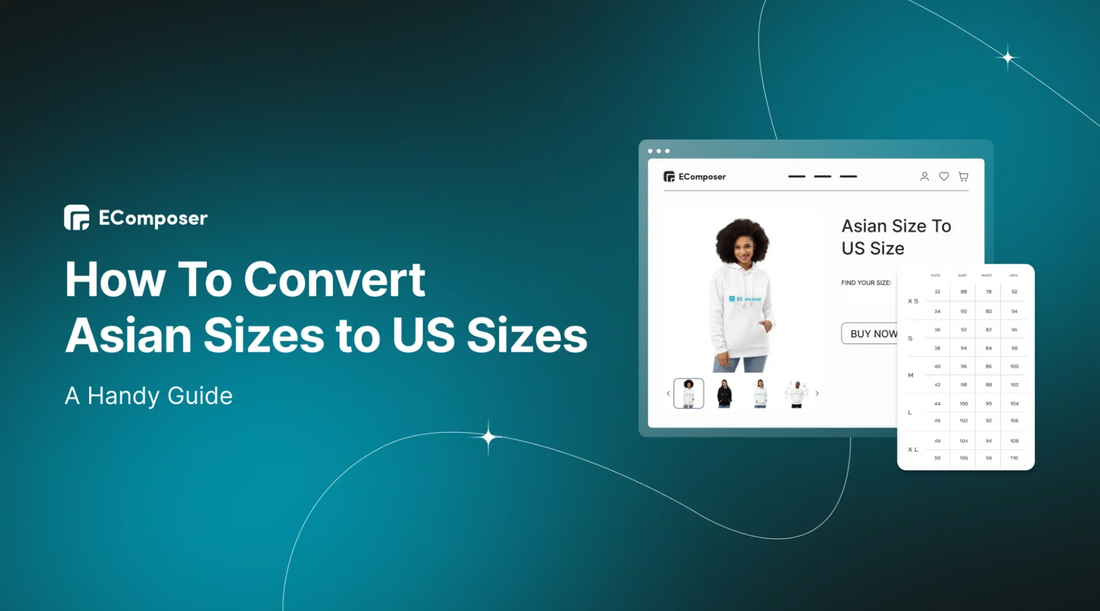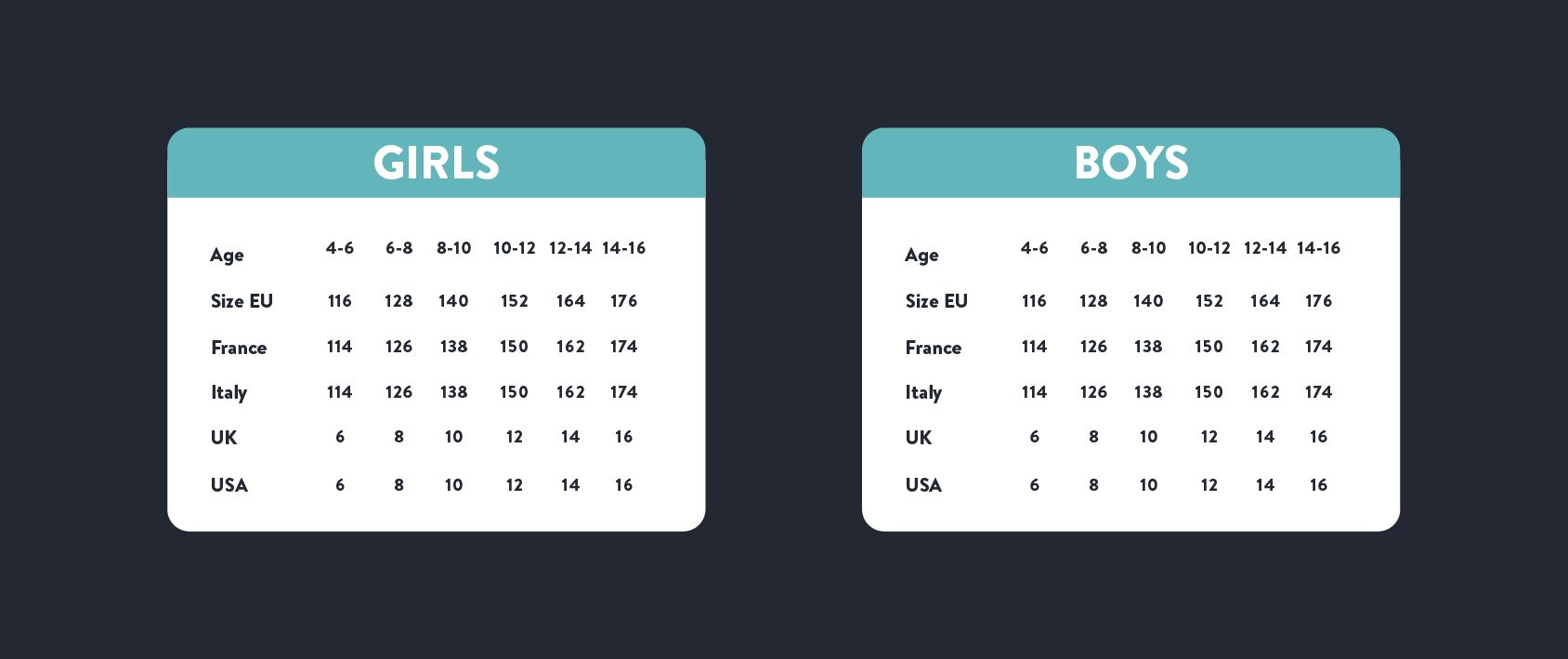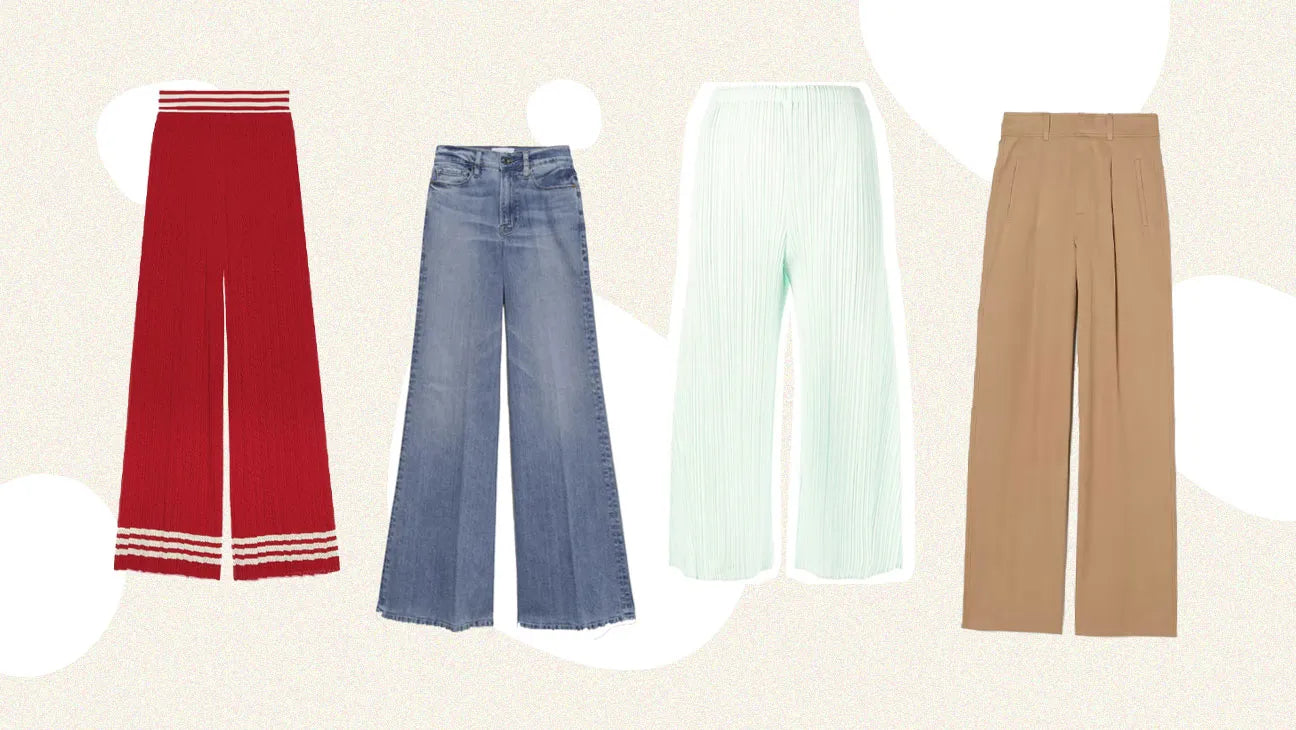How to Convert Asian Sizes to US Sizes - A Handy Guide

Table Of Contents
If your store caters to customers across multiple countries, ensuring seamless shopping experiences hinges on implementing accurate size conversions. After all, nothing dampens a customer's enthusiasm, like receiving a garment that doesn't fit quite right.
In this blog, we will show you How to Convert Asian Sizes to US Sizes. Additionally, we'll explore other popular measurement systems to equip you with comprehensive knowledge for catering to a global clientele. Ready to embark on this journey of sartorial harmony? Let's delve into the art of sizing conversions and unlock the door to customer satisfaction!
Why Is Converting Asian Size To US Size Necessary?

In reality, convenience meets consumer preferences, and accurate sizing transcends mere convenience—it's a cornerstone of customer satisfaction and brand reputation. Let's delve into why converting Asian sizes to US sizes is not just a nicety but a necessity:
- Reducing Return Rates: Clothing and shoes rank among the most frequently returned items in online purchases, with a significant portion attributed to ill-fitting garments. A staggering 38% of online apparel returns stem from sizing discrepancies, highlighting the critical role that accurate size conversions play in minimizing return rates.
- Meeting Customer Expectations: When customers shop online, they expect a seamless experience that mirrors the confidence of in-store purchases. Accurate size conversions enable online sellers to meet these expectations by ensuring customers receive comfortable clothing, fostering trust and loyalty.
- Bridging Cultural Sizing Differences: Asian clothing traditionally features smaller fittings than Western sizes, posing a challenge for international shoppers. By converting Asian sizes to US standards, sellers bridge this gap, providing customers with precise information to make informed purchasing decisions and avoid frustrations.
- Safeguarding Brand Reputation: Consistency is key to maintaining a positive brand image. Inaccurate sizing information can lead to dissatisfaction and reputational damage, eroding customer trust. Conversely, accurate size conversions contribute to positive customer experiences, enhancing brand perception and fostering long-term relationships.
- Mitigating Costs: Handling returns, refunds, and exchanges incurs significant costs for online retailers, with billions spent annually in processing fees and logistics. By proactively providing accurate size information upfront, sellers can minimize the financial burden associated with returns, conserving resources and streamlining operations.
Converting Asian sizes to US sizes isn't just about facilitating transactions—it's about prioritizing customer satisfaction, mitigating risks, and nurturing brand growth in the competitive landscape of online commerce.
Who Is Converting Asian Size to US Size Suitable For?
Converting Asian sizes to US sizes is essential for individuals and businesses, particularly those in the fashion industry. Here's who can benefit from understanding and implementing size conversions:
Online Clothing Retailers
Individuals and businesses selling clothing online, especially those sourcing products from Asian countries like China, Japan, or South Korea, must convert Asian sizes to US sizes. This ensures that customers in the United States receive accurate size information, reducing the likelihood of returns due to sizing issues.
International Businesses
Businesses with transactions spanning multiple countries must convert sizes to accommodate diverse customer bases. By understanding and providing size conversions, these businesses can cater to customers' needs from different regions, offering a seamless shopping experience regardless of geographical location.
Fashion Brands with Global Reach
Fashion brands aiming for global expansion must consider size conversions to penetrate new markets effectively. By converting Asian sizes to US sizes (or vice versa), these brands can ensure that their clothing fits customers across various regions, enhancing customer satisfaction and brand reputation.
Individual Shoppers
Even individual shoppers who purchase clothing directly from international retailers or marketplaces can benefit from knowing how to convert sizes. This knowledge allows them to make informed decisions when selecting clothing items from Asian brands or sellers, reducing the likelihood of ordering ill-fitting garments.
Conversion Charts From Asian Size To US Size
Asian Size to US Size Conversion Chart for Women
Casual Clothing Size
|
International |
China |
Japan |
Korea |
US |
|
XS |
160-165 / 84-86 |
S / 36 / 5 |
44 |
4 |
|
XS |
160-165 / 84-86 |
S / 36 / 7 |
44 |
6 |
|
S |
165-170 / 88-90 |
M / 38 / 9 |
55 |
8 |
|
S |
165-170 / 88-90 |
M / 38 / 9 |
55 |
10 |
|
M |
167-172 / 92-96 |
L / 40 / 11 |
66 |
12 |
|
M |
167-172 / 92-96 |
L / 40 / 11 |
66 |
16 |
|
L |
168-173 / 98-102 |
L, XL / 42 / 13 |
77 |
18 |
|
L |
168-173 / 98-102 |
L, XL / 42 / 13 |
77 |
20 |
|
XL |
170-176 / 106-110 |
XXL / 3L /15 |
88 |
22 |
|
XL |
170-176 / 106-110 |
XXL / 3L /15 |
88 |
24 |
|
XXL |
4L /17 |
26 |
||
|
XXL |
5L /19 |
28 |
Shoe Size
|
India |
China |
Japan |
Korea |
US |
|
31 |
18 |
180 |
1 |
|
|
31.5 |
18.5 |
185 |
1.5 |
|
|
0 |
32 |
19 |
190 |
2 |
|
0.5 |
32.5 |
19.5 |
195 |
2.5 |
|
1 |
33 |
20 |
200 |
3 |
|
1.5 |
33.5 |
20.5 |
205 |
3.5 |
|
2 |
34 |
21 |
210 |
4 |
|
2.5 |
34.5 |
21.5 |
215 |
4.5 |
|
3 |
35 |
22 |
220 |
5 |
|
3.5 |
35.5 |
22.5 |
225 |
5.5 |
|
4 |
36.5 |
23 |
230 |
6 |
|
4.5 |
37 |
23.5 |
235 |
6.5 |
|
5 |
37.5 |
24 |
240 |
7 |
|
5.5 |
38 |
24.5 |
245 |
7.5 |
|
6 |
39 |
25 |
250 |
8 |
|
6.5 |
39.5 |
25.5 |
255 |
8.5 |
|
7 |
40 |
26 |
260 |
9 |
|
7.5 |
40.5 |
26.5 |
265 |
9.5 |
|
8 |
41.5 |
27 |
270 |
10 |
|
8.5 |
41.5 |
27.5 |
275 |
10.5 |
|
9 |
42.5 |
28 |
280 |
11 |
|
9.5 |
43.5 |
28.5 |
285 |
11.5 |
|
10 |
44 |
29 |
290 |
12 |
|
10.5 |
44.5 |
29.5 |
295 |
12.5 |
|
11 |
45.5 |
30 |
300 |
13 |
|
11.5 |
46 |
30.5 |
305 |
13.5 |
|
12 |
46.5 |
31 |
310 |
14 |
|
12.5 |
47 |
31.5 |
315 |
14.5 |
|
13 |
47.5 |
32 |
320 |
15 |
|
13.5 |
48.5 |
32.5 |
325 |
15.5 |
|
14 |
49 |
33 |
330 |
16 |
|
14.5 |
49.5 |
33.5 |
335 |
16.5 |
|
15 |
50 |
34 |
340 |
17 |
Asian Size to US Size Conversion Chart for Men
Casual Clothing Size
|
International |
China |
Japan |
Korea |
US |
|
XS |
S / 36 |
90 |
14 |
|
|
XS |
S / 37 |
90 |
14.5 |
|
|
S |
165 / 88-90 |
M / 38 |
95 |
15 |
|
S |
165 / 88-90 |
M / 39 |
95 |
15 - 15.5 |
|
M |
170 / 96-98 |
L / 40 |
100 |
15.5 - 16 |
|
M |
170 / 96-98 |
L / 41 |
100 |
16 |
|
L |
175 / 108-110 |
L, XL / 42 |
105 |
16.5 |
|
L |
175 / 108-110 |
43 |
105 |
17 |
|
XL |
180 / 118-122 |
44 |
110 |
17.5 |
|
XL |
180 / 118-122 |
44 |
110 |
17.5 |
|
XXL |
185 / 126-130 |
|||
|
XXL |
185 / 126-130 |
Suit/Coat/Sweater Size
|
International |
US / UK / Australia |
EU / Japan |
|
S |
32 |
42 |
|
S |
34 |
44 |
|
S |
36 |
46 |
|
M |
38 |
48 |
|
L |
40 |
50 |
|
L |
42 |
52 |
|
XL |
44 |
54 |
|
XL |
46 |
56 |
Bottoms/Trouser Size
|
UK / US |
EU |
|
32 |
81 cm |
|
34 |
86 cm |
|
36 |
91 cm |
|
38 |
97 cm |
|
40 |
102 cm |
|
42 |
107 cm |
Shoe Size
|
Shoe Size |
Japan |
Korea |
USA, Canada |
Standard EU |
Australia, UK |
|
38 |
24 |
240 |
6 |
38 |
5 |
|
39 |
24.5 |
245 |
6.5 |
38.5 |
5.5 |
|
40 |
25 |
250 |
7 |
39 |
6 |
|
41 |
25.5 |
255 |
7.5 |
40 |
6.5 |
|
42 |
26 |
260 |
8 |
40.5 |
7 |
|
43 |
26.5 |
265 |
8.5 |
41 |
7.5 |
|
44 |
27 |
270 |
9 |
42 |
8 |
|
45 |
27.5 |
275 |
9.5 |
42.5 |
8.5 |
|
46 |
28 |
280 |
10 |
43 |
9 |
|
47 |
28.5 |
285 |
10.5 |
44 |
9.5 |
|
48 |
29 |
290 |
11 |
44.5 |
10 |
|
49 |
29.5 |
295 |
11.5 |
45 |
10.5 |
|
50 |
30 |
300 |
12 |
46 |
11 |
|
51 |
30.5 |
305 |
12.5 |
46.5 |
11.5 |
|
52 |
31 |
310 |
13 |
47 |
12 |
|
53 |
31.5 |
315 |
13.5 |
48 |
12.5 |
Asian Size to US Size Conversion Chart for Kid
Casual Clothing Size
|
International |
China |
Japan |
Korea |
US |
|
XXS |
105 |
100 |
7 |
4 |
|
XS |
115 |
110 |
9 |
5 |
|
S |
115 |
110 |
9 |
6 |
|
S |
125 |
120 |
11 |
7 |
|
M |
125 |
120 |
13 |
8 |
|
M |
135 |
130 |
13 |
10 |
|
L |
145 |
140 |
15 |
12 |
|
XL |
155 |
150 |
17 |
14 |
|
XXL |
165 |
160 |
17 |
16 |
Shoe Size
|
India |
China |
Japan |
Korea |
US |
|
0 |
15 |
8 |
90 |
0.5 |
|
0.5 |
15.5 |
8.5 |
95 |
1 |
|
1 |
16 |
9 |
100 |
1.5 |
|
1.5 |
16.5 |
9.5 |
100 |
2 |
|
2 |
17 |
10 |
105 |
2.5 |
|
2.5 |
18 |
10.5 |
110 |
3 |
|
3 |
19 |
11 |
115 |
3.5 |
|
3.5 |
19.5 |
11.5 |
120 |
4 |
|
4 |
20 |
12 |
125 |
4.5 |
|
4.5 |
20.5 |
12.5 |
125 |
5 |
|
5 |
21 |
13 |
130 |
5.5 |
|
5.5 |
21.5 |
13.5 |
135 |
6 |
|
6 |
22.5 |
14 |
140 |
6.5 |
|
6.5 |
23 |
14.5 |
140 |
7 |
|
7 |
23.5 |
15 |
145 |
7.5 |
|
7.5 |
24.5 |
15.5 |
150 |
8 |
|
8 |
25 |
15.5 |
155 |
8.5 |
|
8.5 |
25.5 |
16 |
160 |
9 |
|
9 |
26 |
16.5 |
160 |
9.5 |
|
9.5 |
27 |
17 |
165 |
10 |
|
10 |
27.5 |
17.5 |
170 |
10.5 |
|
10.5 |
28 |
18 |
175 |
11 |
|
11 |
28.5 |
18.5 |
175 |
11.5 |
|
11.5 |
29 |
18.5 |
180 |
12 |
|
12 |
30 |
19 |
185 |
12.5 |
|
12.5 |
30.5 |
19.5 |
190 |
13 |
|
13 |
31 |
20 |
195 |
13.5 |
|
13.5 |
31.5 |
20.5 |
195 |
1Y |
|
1 |
32.5 |
21 |
200 |
1.5Y |
|
1.5 |
33 |
21.5 |
205 |
2Y |
|
2 |
34 |
21.5 |
210 |
2.5Y |
|
2.5 |
34.5 |
22 |
215 |
3Y |
|
3 |
35 |
22.5 |
220 |
3.5Y |
|
3.5 |
35.5 |
23 |
220 |
4Y |
|
4 |
36.5 |
23.5 |
225 |
4.5Y |
|
4.5 |
37 |
24 |
230 |
5Y |
|
5 |
38 |
24.5 |
235 |
5.5Y |
|
5.5 |
39 |
25 |
245 |
6Y |
How To Take Measurements For Each Type Of Product
Ensuring accurate measurements is crucial when converting Asian sizes to US sizes, as discrepancies can lead to ill-fitting clothing or footwear. Here's a comprehensive guide on how to take measurements for different types of products:
Casual Clothing

- Chest/Bust: Wrap the measuring tape around the fullest part of your chest or bust, ensuring it's parallel to the ground.
- Waist: Measure around the narrowest part of your waist, typically just above the belly button.
- Hips: Measure around the fullest part of your hips, ensuring the tape is parallel to the ground.
Shoes

- Foot Length: Place your foot on a piece of paper and trace around it. Measure the length from the tip of your longest toe to the back of your heel.
- Foot Width: Measure the widest part of your foot.
Suit/Coat/Sweater

- Chest: Wrap the measuring tape around the fullest part of your chest, under your armpits, and across your shoulder blades.
- Shoulder Width: Measure from the edge of one shoulder to the edge of the other shoulder, across the back.
- Sleeve Length: Measure from the top of your shoulder to your wrist.
Bottoms/Trousers

- Waist: Measure around your natural waistline, typically the narrowest part of your torso.
- Hips: Measure around the fullest part of your hips and buttocks.
- Inseam: Measure from the crotch seam to the bottom of the leg along the inside of the leg.
Kids' Clothing

- Height: Measure from the top of the head to the ground without shoes.
- Chest: Wrap the measuring tape around the fullest part of the chest, under the armpits.
- Waist: Measure around the natural waistline.
- Hips: Measure around the fullest part of the hips.
Following these guidelines and accurately measuring yourself or your child can ensure a better fit when converting Asian and US sizes.
Best Practices For Converting Sizes In Your eCommerce Store
Accurate sizing information is pivotal in eCommerce, minimizing returns and fostering positive customer experiences. Implementing best practices for size conversions enables online sellers to effectively elevate customer satisfaction and mitigate sizing-related challenges.
Utilize Size Conversion Tools
Harness the power of size conversion applications to streamline the purchasing journey for customers. These invaluable tools offer seamless conversions between diverse sizing systems, encompassing Asian and US sizes. By integrating a reliable size conversion app into your website or mobile platform, customers can effortlessly identify their appropriate size, catering to a spectrum of preferences and needs.
Using size chart apps, you can also add size charts to your product pages for customer convenience. You can choose a page builder that integrates size chart creation, like EComposer Page Builder. This helps you download only a few apps and create a size chart.
Create detailed size guides
Enhance your customers' shopping experience by investing time and effort in developing a comprehensive size guide. The detailed size chart juxtaposing Asian sizes with corresponding US sizes is an invaluable source of information for consumers looking for the perfect fit. Includes essential measurements such as bust, waist, hips, and inseam length to help customers make informed decisions. Ensure size charts are accessible on your website and product listings, ideally on each product page, to enhance convenience and transparency.
Provide clear size recommendations
Go the extra mile to support your customers by providing precise size recommendations for each product. In addition to presenting a size chart, utilize descriptive language to convey whether an item tends to be minor, significant, or true to size. Consider providing additional guidance, such as suggesting adjustments for the desired fit or giving styling tips to assist customers in choosing the optimal size and minimize misjudgments. This additional information enhances the shopping experience and builds trust and confidence in your brand.
Take advantage of customer feedback
Encourage customers to contribute reviews focusing on product size and fit, leveraging social proof for future buyers. These authentic testimonials provide valuable insights into sizing nuances and assist in determining appropriate sizing conversions, thereby promoting trust and reliability. Promising customer reviews on your website provide transparency and demonstrate your commitment to continuous improvement and customer satisfaction.
Cooperate with suppliers
Foster collaborative partnerships with your Asian suppliers to ensure accuracy and consistency in scale information. Effective communication and collaboration with suppliers allow for collecting detailed dimensional parameters, improving the accuracy of dimensional conversions. By actively engaging with suppliers and sharing valuable insights into customer preferences and trends, you reinforce your commitment to providing quality products and exceptional satisfaction. special. customer differences. This collaborative approach strengthens relationships and ensures a seamless supply chain and enhanced product offerings.
Comply with size standards
Remain vigilant and proactive in keeping updated with international scale standards and industry developments to ensure compliance with recognized principles. Adjusting your size conversions to comply with established standards simplifies the process for sellers and customers and demonstrates your commitment to accuracy and engaging practices. client. commodity-centric.
Final Thoughts
In conclusion, understanding how to convert Asian sizes to US sizes is invaluable for anyone involved in the fashion industry, whether you're an online seller, a shopper, or a supplier. By following the guidelines and best practices outlined in this handy guide, you can confidently navigate the complexities of size conversions, minimize returns, and ensure a seamless shopping experience for customers worldwide. Remember, accurate sizing information is the key to success in the eCommerce landscape. With the right tools and knowledge at your disposal, you can conquer any sizing challenge that comes your way. Happy shopping!





















0 comments